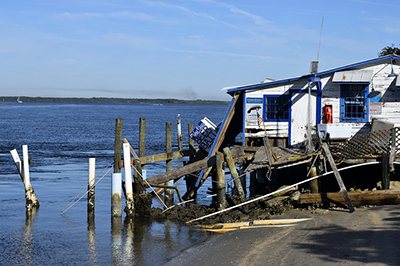While flood insurance can significantly reduce the cost of flood losses and rebuilding, six mitigation measures can help prevent your house from flooding in the first place, even if you live in a special flood hazard area. If your home has sustained previous damage or is at high risk, one of the following mitigation projects may be a good investment and give you peace of mind.

Structural Elevation and/or Re-grading - Raising the existing lowest floor of the building and appliances above the (BFE) Base Flood Elevation plus 1ft of freeboard is the best way to prevent flooding. This can be done by elevating the entire house, including the floor, or by leaving the house in its existing position and constructing a new elevated floor within the home. The method used depends largely on construction type, foundation type, and flooding conditions. Obtain a Permit to re-grade your lot to drain runoff away from buildings.
Wet Flood Proofing - Modifying the uninhabited portions of the house (crawlspace or unfinished basement) so that floodwaters can enter but not cause significant damage to either the house or its contents. This allows interior and exterior hydrostatic pressures to equalize, reducing the likelihood of wall failures and structural damage. Raise electrical panels, AC units, water heaters, and appliances to areas and heights that are above BFE plus 1ft of freeboard.
Relocation - Moving your house to higher ground, outside the flood hazard area. When space permits, it may be possible to relocate the home to higher ground on the same piece of property. Once relocated, utility lines are connected.
Dry Flood Proofing - Sealing your house to prevent floodwaters from entering. Making the house watertight requires sealing the walls with waterproof coatings, impermeable membranes, or supplemental layers of masonry or concrete. Doors, windows, and other openings below flood levels are equipped with permanent or removable shields and backflow valves must be installed in sewer lines and drains.
Demolition - Tearing down a damaged or high-risk structure and either rebuilding properly somewhere on the same property or moving to a house onto other property outside the regulatory floodplain.
Acquisition of Flood-Prone Properties - Properties that meet FEMA's definition of repetitive flood losses may qualify for acquisition by federal, state, and local governmental agencies with the stipulation that the land is maintained as open space and not be redeveloped.
- The City of Corpus Christi Housing & Community Development Department heads the Community Development Block Grant Program Disaster Recovery (CDBG-DR) Voluntary Buyback program for efficiently removing repetitive loss, severe repetitive loss, and otherwise vulnerable housing from regulatory floodways while assisting homeowners with the process of purchasing safe replacement homes outside of the areas of hazard.
- The NFIP maintains a listing of properties identified as either Repetitive loss (RLP) or Severe Repetitive Loss (SRLP). In 2020, there were a total of 205 RLP's and 25 SLP's identified within the City of Corpus Christi.
- The Housing & Community Development & Floodplain Management Departments strive to work with property owners to undertake flood mitigation measures such as buyout, relocation, elevation, or otherwise improving structures. Hence, they are no longer subject to repetitive flood damage.
- For more information, visit: Grant Monitoring Division | City of Corpus Christi (cctexas.com)
Reducing Flood Risk to Residential Buildings That Cannot Be Elevated
FEMA P-1037 / September 2015

